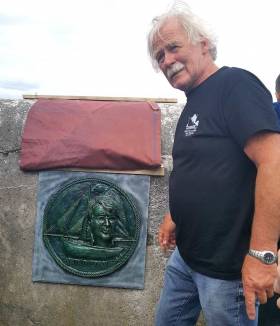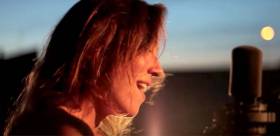Displaying items by tag: Cruinniu na mBad
Kinvara’s annual Cruinniú na mBád takes to the water this weekend, with racing confined to Sunday due to weather conditions.
A small craft warning for Saturday means the festival’s activity will be shore-based for the first day of the 44th annual event.
A barbecue will take place at Parkmore Pier on Saturday from 2 pm, and Bord Iascaigh Mhara and Cuan Beo, the south Galway environmental awareness group, will be among the exhibitors on Kinvara Pier.
 Tight competition can be seen in the gleoiteoga beaga class, where the overall winner of the year is still up for grabs , and the points are tight between the McHugh, Naomh Stiofán and the Naomh Feichin Photo: Máire Ní Éinniú
Tight competition can be seen in the gleoiteoga beaga class, where the overall winner of the year is still up for grabs , and the points are tight between the McHugh, Naomh Stiofán and the Naomh Feichin Photo: Máire Ní Éinniú
The regular sean-nós singing event will be one of the musical highlights of the programme, taking place on Saturday night in Kinvara’s community centre.
A mass and blessing of boats is scheduled for 12 noon on Sunday, and the gleoiteog race starts at 2 pm.
The fleet of Galway hookers carrying turf across the bay is due in from 4 pm on Sunday, and visitors can bring a bag and “take home some unique Connemara sods”, organiser Dr Michael Brogan says.
 McHugh. Built by Paraic O Cathasaigh in 1917 helmed by Dónal Mac Donncha and his crew of Keith Ridge and Seán Éinniú. One of the oldest boats still competing Photo: Máire Ní Éinniú
McHugh. Built by Paraic O Cathasaigh in 1917 helmed by Dónal Mac Donncha and his crew of Keith Ridge and Seán Éinniú. One of the oldest boats still competing Photo: Máire Ní Éinniú
Racing for the leath bhád and bád mór classes is scheduled from 5 pm on Sunday.
During Sunday afternoon, the Green Island swim is due to start at 3.30 pm, and the climín (seaweed raft) race is scheduled for around 3 pm.
“This has to be the longest-running maritime event in the country, as we even managed to take a few sods of turf over the bay during Covid-19, “Dr Brogan, its chief organiser, says.
Four years ago, a plaque dedicated to the late festival founder Tony Moylan, designed by sculptor John Coll, was unveiled at Kinvara pier to mark the 40th anniversary of the Galway hooker gathering.
Last weekend, Galway hooker skippers competed in a regatta hosted by Bádóirí an Cladaigh, as part of the Cumann Huicéirí na Gaillimhe series of sailing racing competitions.
An Mhaighdean Mhara First Boat Home in Cruinniú na mBád Turf Race
Thunderstorms forced postponement of racing at the Cruinniú na mBád in Kinvara, Co Galway on Sunday for safety reasons, and the fleet will reconvene on Thursday.
However, An Mhaighdean Mhara was first boat home in the turf race from Parkmore to Kinvara on Saturday when hundreds of people attended the 43rd annual event.
The bád mór was followed by An Tonaí in light winds and an incoming tide, while gleoiteogs competed in the outer bay.
The St Catherine won the gleoteoig class, followed by Naomh Ciarán and An Phantra.
The Naomh Stiofáin won the gleoiteog beaga class, with second place going to the McHugh, according to festival organiser Dr Michael Brogan.
Sun was shining with record temperatures when the climín or seaweed contest took place in the inner harbour.
 Climin race 2022 at Cruinniu na mBad Kinvara with Karen Weekes and Orla Knight the first female competitors Photo: Michael Brogan
Climin race 2022 at Cruinniu na mBad Kinvara with Karen Weekes and Orla Knight the first female competitors Photo: Michael Brogan
Solo transatlantic rower Dr Karen Weekes and Orla Knight became first females to compete, and the race was won by PJ and Michael from An Cheathrú Rua.
There to pay tribute to the festival effort was Independent TD for Roscommon-Galway Michael Fitzmaurice, who said he had taken a break from baling hay.
 Roscommon-Galway TD Michael Fitzmaurice (Ind) on board An Tonaí at Parkmore pier, before it left for Cruinniú na mBád in Kinvara Photo: Michael Brogan
Roscommon-Galway TD Michael Fitzmaurice (Ind) on board An Tonaí at Parkmore pier, before it left for Cruinniú na mBád in Kinvara Photo: Michael Brogan
“This is a long way out of my constituency, but these people have to be saluted for the work that has gone in to keeping this tradition alive,”Fitzmaurice said, standing on the deck of An Tonaí before it left with its turf cargo from Parkmore pier.
“It is keeping a torch lit, and it is great to hear that a lot of young people are involved in sailing these traditional vessels,” he said.
“This what Ireland is good at, all the villages around here are thronged with people today,” Fitzmaurice said.
“After a lot of beating and twisting and turning with Government, it has been agreed that when you own a bog, as people do in Connemara, you can cut it, you can give it or you can sell that turf yourself,” Fitzmaurice said.
Fine Gael Junior Housing Minister Peter Burke is due to sign the final regulations into law in the autumn, banning smoky fuel sales on retail premises and online, while preserving the entitlement of those with turbary rights to sell or give away their turf supplies.
“We have to remember that Bord Fáílte (former title for Fáilte Ireland) was the State body showing the person footing the bit of turf in the west of Ireland and the open fire – and sadly some people in Dublin 4 don’t understand our way of life, our heritage, our tradition, and, above all, our fuel supply,” Fitzmaurice said.
Declan O’Rourke, John Faulkner, Tony Trundel, Steve Johnston and Paul Mulligan were among musicians performing in Kinvara, and a hurling tournament was held in memory of festival founder Tony Moylan.
In 1979, Moylan persuaded three of the oldest wooden-built trading vessels with their distinctive “tumblehome” hulls to revive the sea journey from south Connemara to south Galway, where the limestone landscape meant communities had little access to turf.
After a forced pandemic suspension, the Cruinniú na mBád festival of traditional craft returns this weekend to Kinvara, Co Galway.
The opening ceremony tonight, Friday, August 12th, will include speakers Dr Karen Weekes, the first Irish woman to row solo across the Atlantic, poster artist Lily Johnston, and local musicians attending will include Declan O’Rourke, John Faulkner, Tony Trundel, Steve Johnston and Paul Mulligan.
Kinvara’s Friday farmers’ market runs, as usual, this afternoon, while a hurling tournament will take place this evening in memory of festival founder Tony Moylan.
At the 40th anniversary cruinniú August 2019, a plaque dedicated to Moylan was unveiled at the Kinvara pier head, along with a wooden bench made by Kinvara men’s shed group.
 Padraig Bailey tidies up the turf on the deck of the Galway Hooker, An Capall, after arriving off Parkmore on the the first leg of the turf race at the 2011 Cruinniu na mBad Festival Photo: Joe O'Shaughnessy
Padraig Bailey tidies up the turf on the deck of the Galway Hooker, An Capall, after arriving off Parkmore on the the first leg of the turf race at the 2011 Cruinniu na mBad Festival Photo: Joe O'Shaughnessy
In 1979, Moylan persuaded three of the oldest turfboats – Galway “bád mór” hookers, An Capall, An Tonaí and An Maighdean Mhara- to revive a sea journey from south Connemara to south Galway.
The wooden-built trading vessels with their distinctive “tumblehome” hulls had delivered turf to south Galway, Clare and the Aran Islands for generations, as neither the limestone Burren on Clare’s coast nor the Aran islands had landscape for turf.
 An Tonai sails past Dunguaire Castle to Kinvara pier at the finish of the turf race at Cruinniu na mBad Joe O'Shaughnessy
An Tonai sails past Dunguaire Castle to Kinvara pier at the finish of the turf race at Cruinniu na mBad Joe O'Shaughnessy
As Afloat reported earlier, that vital freight journey will be remembered tomorrow, Saturday, August 13th, when a fleet loaded up with turf sods at Parkmore pier at 2.30 pm will sail into Kinvara at around 5 pm.
Saturday’s first event is horseshoe throwing from 12 noon, a village fete at the quay from 1 pm, the “Green Island” swim at 4 pm, and the fleet “sail-in” at 5 pm. Live music in Tully’s Bar on Saturday night will be performed by the Vibe Tribe.
On Sunday, August 14th, there will be outdoor mass at 12 noon and both horseshoe throwing and the village fete resume.
While Tully’s bar hosts a live “trad” music session from 3 pm, the race of hookers, including the bád mor, leath-bhád, gleoiteog and pucán, will set off from 3 pm out in the bay.
 The cargo is thrown ashore from the Galway hooker An Tonai at Kinvara Pier following the 2011 Turf Race at Cruinniu na mBad Photo: Joe O'Shaughnessy
The cargo is thrown ashore from the Galway hooker An Tonai at Kinvara Pier following the 2011 Turf Race at Cruinniu na mBad Photo: Joe O'Shaughnessy
A children’s fancy dress contest takes place at 4 pm on Sunday, and the hotly contested climín or seaweed raft race is on the water at 4pm. Among the participants will be a team including transatlantic oarswoman Dr Karen Weekes.
The cruinniú award ceremony is scheduled for 5 pm, and there will also be an auction of paintings, before it closes on Sunday evening.
Kinvara is Back! Cruinniu na mBad Leaps To Life This Weekend With The Festival Of The Traditional Boats
When the highly-respected Organising Chairman Dr Mick Brogan declared - in May 2020 - that the annual Cruinniu na mBad - the Gathering of the Boats - could not be held in August at Kinvara in face of the spread of the COVID pandemic, "See You In 2021" became the mutually-supportive greeting among the festival's many enthusiasts.
Yet if ever there was a "Super-spreader Event Competition", then Kinvara's three days of intensive festivities afloat and ashore would win by a large margin. So there was no way it could be held in 2021 either.
But this weekend from 12th to 14th August, Cruinniu na mBad 2022 at Kinvara is back in turbo-powered style, complete with the promise of good weather to do it justice. It is a celebration of just about every aspect of life in the west of Ireland, presented with a nautical flavour. And apart from the traditional unloading of the turf which will have been sailed in across Galway Bay by the hookers from south Connemara, for those whose main interest is sailing the focus of the racing takes place right off the pierhead on Sunday afternoon.
 An ancient festival, Cruinniu na mBad at Kinvara was revived on an annual basis in 1979
An ancient festival, Cruinniu na mBad at Kinvara was revived on an annual basis in 1979
Cruinniú na mBád Founder Immortalised in Kinvara
The Galway man who is regarded as a leading light in the revival of interest in Irish turf trading craft has been immortalised in his home harbour writes Lorna Siggins
Figurative sculptor John Coll has designed a plaque depicting the late Tony Moylan, which has been unveiled at the head of Kinvara pier.
Mr Moylan’s widow Phil attended the unveiling to mark the 40th anniversary of the annual gathering of Galway hookers, which took place in Kinvara bay over the past weekend.
Dr Michael Brogan, a close friend and of the festival’s main organisers, said the plaque had been cleverly sculpted to incorporate a bird with an egg in its mouth - reflecting Mr Moylan’s role in Fleadh na gCuach, Kinvara’s highly successful” cuckoo festival” of traditional music.
“Tony didn’t just form Cruinniú na mBád, he also founded Fleadh na gCuach, “Dr Brogan said.
A carved bench made by the Kinvara men’s shed group has been placed at the pier head beside the plaque to remember Mr Moylan.
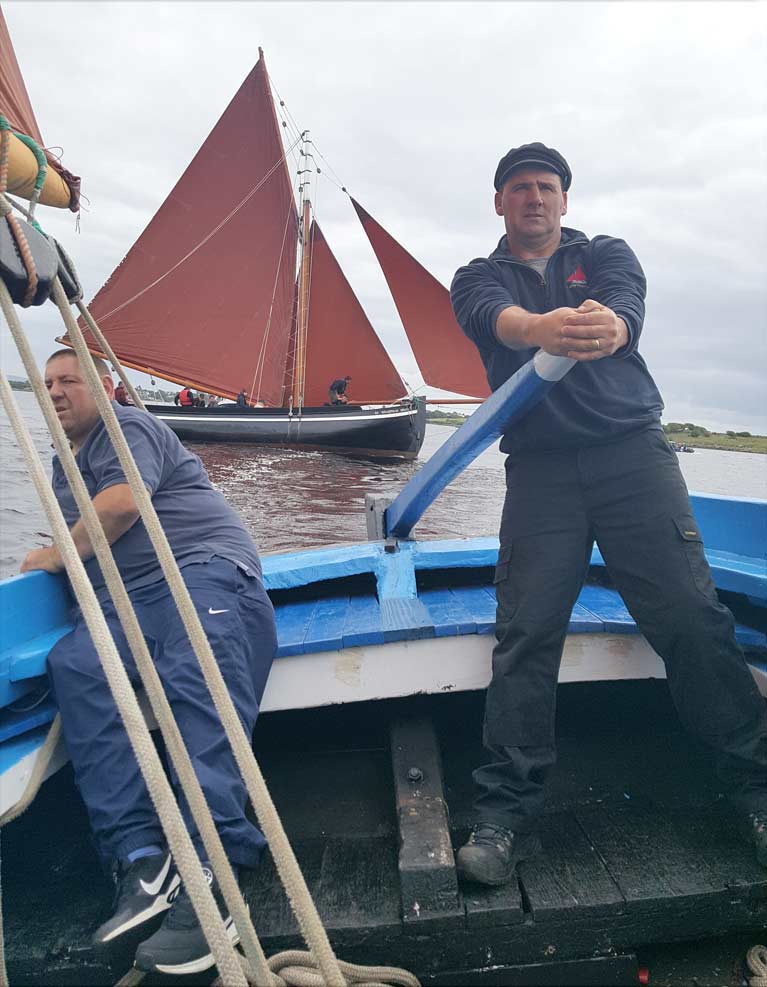 The helmsman of the Galway Hooker An Capall, Dara Flaherty
The helmsman of the Galway Hooker An Capall, Dara Flaherty
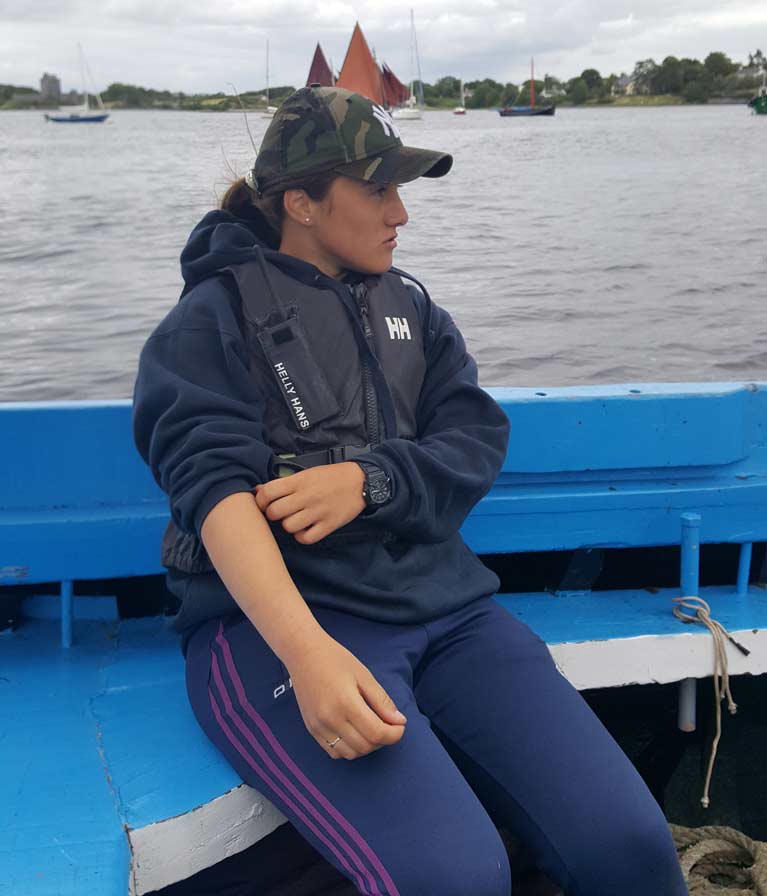 Chantal Flaherty, a crew member of An Capall where her father is the helmsman
Chantal Flaherty, a crew member of An Capall where her father is the helmsman
“The seat is in the shape of the middle beam of a hooker...it even has the bend of a hooker on it. So people can come here and talk to Tony, and sit down in peace and quiet, “Dr Brogan said.
It was Mr Moylan who persuaded three of the oldest turfboats - An Capall, An Tonaí and An Maighdean Mhara- to revive a sea journey from south Connemara to south Galway in 1979.
The limestone Burren and neighbouring Aran islands had no landscape for turf, and the trading vessels with their distinctive “tumblehome” hulls carried turf to south Galway, Clare and the Aran Islands for generations.
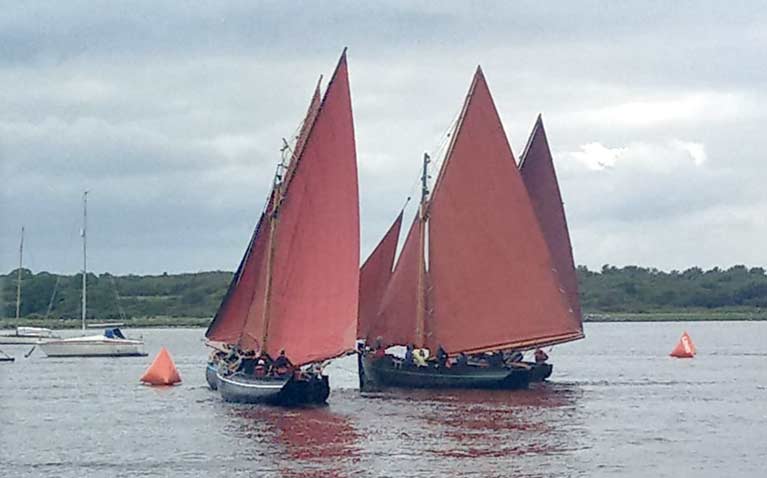
All three vessels, classed as “bád mór” or the largest design in the Galway hooker fleet, have participated in the annual “Cruinniú” in Kinvara for years as part of the regatta season.
An Capall, built in the 1860s in Leitir Móir and owned and fished by the late Johnny Bailey, sailed under the helm of Dara Flaherty at the weekend, with Bailey’s son Pádraig and Flaherty’s daughter Chantal (14) among the crew.
Former badóirí who have passed away were remembered during the 40th-anniversary event, which was attended by hundreds of people.
Music, horseshoe throwing, a harbour swim, seaweed raft racing and talks hosted by the Cuan Beo environmental organisation based in south Galway took place during the three-day event.
Heavy rain and gales disrupted gleoiteog racing on Saturday, but moderate winds on Sunday made for keen racing up Kinvara bay, with a fleet of six bád mór vessels chased by the leath-bhád or smaller design.
The Irish Coast Guard’s Shannon-based Rescue 115 helicopter flew over the course, and the RNLI was among organisations represented on the pier.
A community campaign to declare Kinvara free of single-use plastics was also initiated over the weekend. The campaign includes an “earth keepers’” initiative for young school children and is supported by the local tidy towns committee.
Kinvara Goes Single-Use Plastic-Free on Eve of Cruinniu na mBád
Samba rhythm music declared a “single-use-plastic-free” zone in the south Galway harbour of Kinvara yesterday as it prepared for the annual Cruinniú na mBád writes Lorna Siggins.
The fragility of the marine environment is a theme of this weekend’s festival, which marks 40 years since a fleet of Galway hookers laden with turf appeared out of the mist into Kinvara bay.
Three billboards created by Kinvara teenagers were unveiled yesterday evening as part of an initiative to reduce single-use plastics in the community.
Six students worked with artist and muralist Shona MacGillivray, who is based in Gort, Co Galway – drawing inspiration from English street artist Banksy and contemporaries for the environmental messages.
The project is spearheaded by a community group “Plastic-free Kinvara”, founded in March 2018.
"The cooperation from our community has been tremendous," the group’s joint chair, Anna Murphy, said.
A full programme of events on and off the water over the weekend kicks off today with a cookery demonstration by Marianne Krause at midday.
Artist and author Gordon D’Arcy will talk about coastal birdlife, and south Galway documentary-makers Jill Beardsworth and Keith Walsh will speak about their 2018 film production, entitled When All is Ruin Once Again.
As Afloat reported previously, Pianist, songwriter and sailor Marieke Husymans of the Pianocean project will perform at 2.30pm on Saturday and 3 pm on Sunday on her vessel, Lady Flow, berthed at Kinvara quay.
Galway boatbuilder and sailor Coilín Hernon will talk about his work with traditional craft on Sunday.
Efforts to restore native oyster stocks and protect marine mammals will also be addressed by Bord Iascaigh Mhara inshore fisheries development co-ordinator Oliver Tully and Dr Simon Berrow of the Irish Whale and Dolphin Group.
Festival organiser Dr Michael Brogan and film-maker Bob Quinn marked 40 years of the cruinniú last night – recalling the first event on a “wet Friday evening in August 1979” when the fleet sailed in after an absence of 20 years.
That fleet was led by three of the oldest turfboats - An Capall, An Tonai and An Maighdean Mhara, each of which had traded turf to Kinvara, Clare and the Aran Islands for generations.


























